Regression and forecasting
Bayesian Data Analysis in Python

Michal Oleszak
Machine Learning Engineer
Linear regression
$$y = \beta_0 + \beta_1x_1 + \beta_2x_2 + ...$$
$$\text{sales} = \beta_0 + \beta_1\text{marketingSpending}$$
Frequentist inference:
$\text{sales} = \beta_0 + \beta_1\text{marketingSpending} + \varepsilon$
$\varepsilon \sim \mathcal{N} (0, \sigma)$
Bayesian inference:
- $\text{sales} \sim \mathcal{N} (\beta_0 + \beta_1\text{marketingSpending}, \sigma)$
Normal distribution
normal_0_1 = np.random.normal(0, 1, size=10000)sns.kdeplot(normal_0_1, shade=True, label="N(0,1)") plt.show()

Normal distribution
normal_0_1 = np.random.normal(0, 1, size=10000)
normal_3_1 = np.random.normal(3, 1, size=10000)
sns.kdeplot(normal_0_1, shade=True, label="N(0,1)")
sns.kdeplot(normal_3_1, shade=True, label="N(3,1)")
plt.show()

Normal distribution
normal_0_1 = np.random.normal(0, 1, size=10000)
normal_3_1 = np.random.normal(3, 1, size=10000)
normal_0_3 = np.random.normal(0, 3, size=10000)
sns.kdeplot(normal_0_1, shade=True, label="N(0,1)")
sns.kdeplot(normal_3_1, shade=True, label="N(3,1)")
sns.kdeplot(normal_0_3, shade=True, label="N(0,3)")
plt.show()

Bayesian regression model definition
$$\text{sales} \sim \mathcal{N} (\beta_0 + \beta_1\text{marketingSpending}, \sigma)$$
$$\beta_0 \sim \mathcal{N} (5, 2)$$
$$\beta_1 \sim \mathcal{N} (2, 10)$$
$$\sigma \sim \mathcal{Unif} (0, 3)$$
- We expect $5000 sales without any marketing.
- We expect $2000 increase in sales from each 1000 increase in spending.
- Uniform prior for standard deviation, as we don't know what it could be.
Estimating regression parameters
- Grid approximation → impractical for many parameters
- Choose conjugate priors and simulate from a known posterior → unintuitive priors
- Third way: simulate from the posterior even with non-conjugate priors!
- For now, assume the parameter draws are given
Plot posterior
$$\text{sales} = \beta_0 + \beta_1\text{marketingSpending}$$
print(marketing_spending_draws)
array([9.6153, 8.9922, ..., 4.59565])
import pymc3 as pm
pm.plot_posterior(
marketing_spending_draws,
hdi_prob=0.95
)

Posterior draws analysis
posterior_draws_df = pd.DataFrame({ "intercept_draws": intercept_draws, "marketing_spending_draws": marketing_spending_draws, "sd_draws": sd_draws })print(posterior_draws_df)
intercept_draws marketing_spending_draws sd_draws
count 10000.000000 10000.000000 10000.000000
mean 2.972130 5.999146 1.337621
std 3.008565 2.020708 0.471723
min -8.562093 -2.842438 0.029643
25% 0.972832 4.621807 1.003229
50% 3.002940 5.975067 1.427617
75% 5.020615 7.362572 1.736310
max 15.228549 13.258955 1.999834
Predictive distribution
How much sales can we expect if we spend $1000 on marketing?
$\text{sales} \sim \mathcal{N} (\beta_0 + \beta_1\text{marketingSpending}, \sigma)$
# Get point estimates of parameters intercept_mean = intercept_draws.mean() marketing_spending_mean = marketing_spending_draws.mean() sd_mean = sd_draws.mean()# Calculate mean of predictive distribution predictive_mean = intercept_mean + marketing_spending_mean * 1000# Simulate from predictive distribution prediction_draws = np.random.normal(predictive_mean, sd_mean, size=10000)
Predictive distribution
How much sales can we expect if we spend $1000 on marketing?

Let's regress and forecast!
Bayesian Data Analysis in Python

